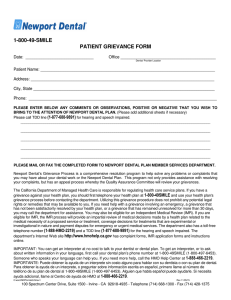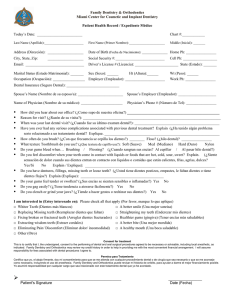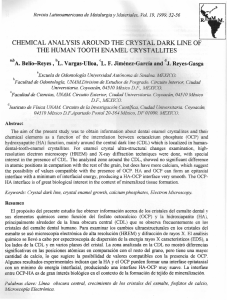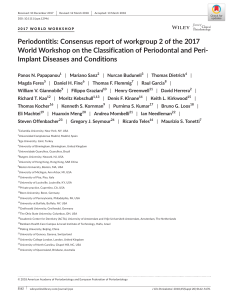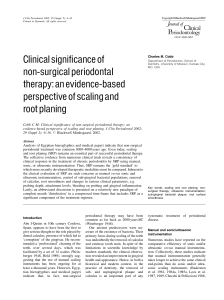Conventional X-ray analysis of porcine (Sus domesticus
Anuncio
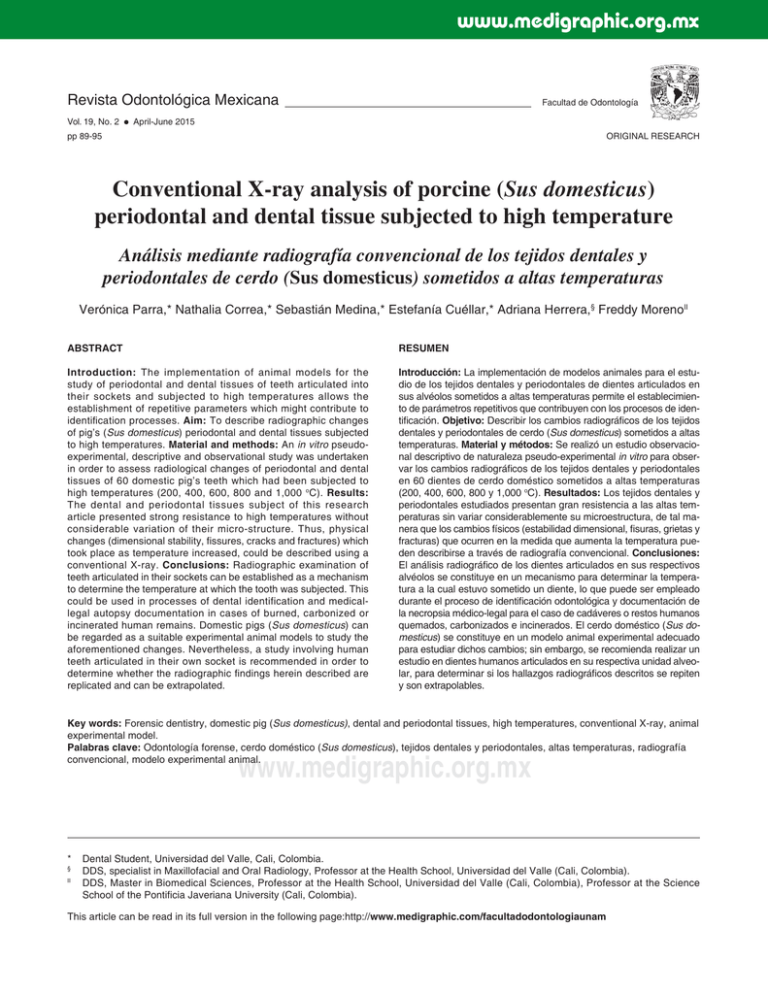
www.medigraphic.org.mx Revista Odontológica Mexicana Vol. 19, No. 2 Facultad de Odontología April-June 2015 ORIGINAL RESEARCH pp 89-95 Conventional X-ray analysis of porcine (Sus domesticus) periodontal and dental tissue subjected to high temperature Análisis mediante radiografía convencional de los tejidos dentales y periodontales de cerdo (Sus domesticus) sometidos a altas temperaturas Verónica Parra,* Nathalia Correa,* Sebastián Medina,* Estefanía Cuéllar,* Adriana Herrera,§ Freddy MorenoII ABSTRACT RESUMEN Introduction: The implementation of animal models for the study of periodontal and dental tissues of teeth articulated into their sockets and subjected to high temperatures allows the establishment of repetitive parameters which might contribute to identification processes. Aim: To describe radiographic changes of pig’s (Sus domesticus) periodontal and dental tissues subjected to high temperatures. Material and methods: An in vitro pseudoexperimental, descriptive and observational study was undertaken in order to assess radiological changes of periodontal and dental tissues of 60 domestic pig’s teeth which had been subjected to high temperatures (200, 400, 600, 800 and 1,000 oC). Results: The dental and periodontal tissues subject of this research article presented strong resistance to high temperatures without considerable variation of their micro-structure. Thus, physical changes (dimensional stability, fissures, cracks and fractures) which took place as temperature increased, could be described using a conventional X-ray. Conclusions: Radiographic examination of teeth articulated in their sockets can be established as a mechanism to determine the temperature at which the tooth was subjected. This could be used in processes of dental identification and medicallegal autopsy documentation in cases of burned, carbonized or incinerated human remains. Domestic pigs (Sus domesticus) can be regarded as a suitable experimental animal models to study the aforementioned changes. Nevertheless, a study involving human teeth articulated in their own socket is recommended in order to determine whether the radiographic findings herein described are replicated and can be extrapolated. Introducción: La implementación de modelos animales para el estudio de los tejidos dentales y periodontales de dientes articulados en sus alvéolos sometidos a altas temperaturas permite el establecimiento de parámetros repetitivos que contribuyen con los procesos de identificación. Objetivo: Describir los cambios radiográficos de los tejidos dentales y periodontales de cerdo (Sus domesticus) sometidos a altas temperaturas. Material y métodos: Se realizó un estudio observacional descriptivo de naturaleza pseudo-experimental in vitro para observar los cambios radiográficos de los tejidos dentales y periodontales en 60 dientes de cerdo doméstico sometidos a altas temperaturas (200, 400, 600, 800 y 1,000 oC). Resultados: Los tejidos dentales y periodontales estudiados presentan gran resistencia a las altas temperaturas sin variar considerablemente su microestructura, de tal manera que los cambios físicos (estabilidad dimensional, fisuras, grietas y fracturas) que ocurren en la medida que aumenta la temperatura pueden describirse a través de radiografía convencional. Conclusiones: El análisis radiográfico de los dientes articulados en sus respectivos alvéolos se constituye en un mecanismo para determinar la temperatura a la cual estuvo sometido un diente, lo que puede ser empleado durante el proceso de identificación odontológica y documentación de la necropsia médico-legal para el caso de cadáveres o restos humanos quemados, carbonizados e incinerados. El cerdo doméstico (Sus domesticus) se constituye en un modelo animal experimental adecuado para estudiar dichos cambios; sin embargo, se recomienda realizar un estudio en dientes humanos articulados en su respectiva unidad alveolar, para determinar si los hallazgos radiográficos descritos se repiten y son extrapolables. Key words: Forensic dentistry, domestic pig (Sus domesticus), dental and periodontal tissues, high temperatures, conventional X-ray, animal experimental model. Palabras clave: Odontología forense, cerdo doméstico (Sus domesticus), tejidos dentales y periodontales, altas temperaturas, radiografía convencional, modelo experimental animal. www.medigraphic.org.mx * § II Dental Student, Universidad del Valle, Cali, Colombia. DDS, specialist in Maxillofacial and Oral Radiology, Professor at the Health School, Universidad del Valle (Cali, Colombia). DDS, Master in Biomedical Sciences, Professor at the Health School, Universidad del Valle (Cali, Colombia), Professor at the Science School of the Pontificia Javeriana University (Cali, Colombia). This article can be read in its full version in the following page:http://www.medigraphic.com/facultadodontologiaunam 90 Parra V et al. Conventional X-ray analysis of porcine (Sus domesticus) periodontal and dental tissue subjected to high temperature INTRODUCTION Assessment of dental (enamel, dentin and cement) and periodontal (oral mucosa, alveolar compact bone and alveolar cancellous bone) tissues by means of different methods and techniques represents a valuable post mortem information source when undertaking identification processes based on teeth evidence. 1-3 Bearing this in mind, the purpose of the present study was to conduct a Cone Beam radiographic analysis of mandibular premolars extracted from domestic pig (Sus domesticus) articulated into their alveoli and subjected to high temperatures (200, 400, 600, 800 and 1,000 o C). The purpose of the study was to establish an experimental animal model which might explain radiographic changes of periodontal and dental tissues so as to be able to identify and obtain repetitive markers which could be extrapolated to human beings. Additionally, these markers could contribute to dental identification forensic procedures as well as documentation of medical and legal necropsies. This could provide significant information during post mortem dental records (exposition time to high temperatures, maximum temperature reached, relationship between dental and periodontal tissues) and during the collation with ante-mortem dental records, and thus acquire sufficient positive characteristics to allow for positive identification of a burned, carbonized or incinerated individual. MATERIAL AND METHODS The present study was of a descriptive, crosssectioned, observational and pseudo-experimental nature. With the help of periapical X-rays, 60 mandibular premolars of domestic pig (Sus domesticus) were examined at high temperatures (200, 400, 600, 800 and 1,000 o C). These teeth exhibited dental (enamel, dentin and cement) and periodontal (oral mucosa alveolar compact bone and alveolar cancellous bone) tissues in suitable clinical circumstances. No specimen was lost during procedures of harvesting (biopsies), manipulation (subjection to high temperatures) and observation (conventional X-rays). the Social Protection Ministry4 established this study did not represent danger to the animals, sample harvesting was conducted from pigs mandibles obtained from food processing plants. Sample handling and preservation Articulated premolars were collected in their alveoli once the pig’s mandibles were secured and before interrupting the cold chain. The system used to achieve this goal was longitudinal sagittal sections executed with a manual saw, taking care to preserve lining oral mucosa, bone tissue and dental tissues. Each specimen was individually placed in a plastic container which contained buffered formalin (100 mL formalin at 37%, 900 mL distilled water, 0.4 mL monobasic sodium phosphate and 0.65 dibasic sodium phosphate).5 Diagnostic tests A periapical X-ray was taken before subjecting specimens to high temperatures. This was executed at the Maxillofacial and Oral Radiology Unit of the Universidad del Valle Dental School. Equipment used was Gendex®-Gx770 dental X-rays equipment, at 14 impulses. Reference point was spatial orientation of the vestibular surface towards the cone, at a 17 cm distance from the base of the cone to the sample. Phosphorylated periapical X-ray films system of Digora’s Soredex® Imaging Plates brand were used. They were scanned into a digital intraoral X-ray system (Express®), to be later visualized through a software called Cliniview XV® Dental Imaging, standard version 3.12.9. Subjection to high temperatures The process was executed according to scientific and technical protocol established at the Dental Materials Unit of the Dental Stomatology Department of the University of Pavia 6 (Italy), and based on studies conducted at the Dental School of the Universidad del Valle.7,8 Specimens were first fixated, then randomly classified into two groups: ten specimens composed a control group which was not subjected to high temperatures; 50 specimens formed the intervention group which was subjected to high temperatures (Table I). Specimens of the intervention group were placed in individual trays of refractory lining (Cera-Fina ® Whip Mix ®) in order to ease manipulation. They were then subjected to www.medigraphic.org.mx Sample harvesting Once the Animal Ethics Institutional Revision Committee of the Health School of the del Valle University, in accordance with Resolution 8430 of Revista Odontológica Mexicana 2015;19 (2): 89-95 91 Table I. Sample classification. Control group 30 oC 10 Intervention group 200 oC 10 400 oC 10 600 oC 10 800 oC 10 1000 oC 10 Table II. Frequency of radiographic changes. Periodontal ligament space Temperature Enamel Dentin Cement 200 oC Fissure Presence (60%) Fissure presence No changes (60%) observed (60%) No changes No changes No changes observed (100%) observed (100%) observed (100%) 400 oC Cracks continuing towards dentin (80%) Cracks projecting Cracks from enamel continuing (80%) towards dentin (80%) No changes No changes Alteration of observed (100%) observed (100%) trabecular bone (80%) 600 oC Presence of cracks and fissures (100%) Presence of cracks and fissures (100%) Presence of cracks and fissures (80%) Loss of continuity Loss of continuity Alteration of (80%) at bifurcation trabecular bone level (80%) (80%) 800 oC Enamel Dentin fragmentation fragmentation (100%) and (100%) loss of enamel fragments (20%) Cement fragmentation (100%) Continuity loss Continuity loss at and thickness bifurcation level increase (100%) and marginal crests (100%) Alteration of trabecular bone and presence of cracks (100%) 1,000 oC Enamel Dentin fragmentation fragmentation (100%) and (100%) loss of enamel fragments (80%) Cement fragmentation (100%) Continuity loss Continuity loss at and thickness bifurcation level increase (100%) and marginal crests (100%) Alteration of trabecular bone and continuity loss due to fracture (100%) direct heat in a muffle-type oven (Thermolyne ® ). This oven had previously been calibrated to five different temperature ranges (200, 400, 600, 800, 1,000 oC). The ascending rate was 10 oC per minute, starting from an initial temperature of 30 o C until reaching each of the established temperatures. For instance, the 10 specimens which formed the 200 o C group were introduced, each in its own tray, in a temperature range from 30 to 200 oC. The oven was then left to cool at room temperature and then trays with specimens were removed. This procedure was equally executed for specimen groups at 400, 600, 800 and 1,000 oC. When a tooth articulated in its own socket is subjected to high temperatures, it can experience the following changes: a) remain intact, b) burned (change of color and formation of fissures or cracks), c) carbonized (reduced to carbon through an incomplete combustion), d) incinerated (reduced to ashes), and e) burst (dental-root and crown-and bone explosion). Specimens were sprayed with hairspray so as to Compact bone Spongy bone provide them with structural soundness and ease their manipulation.9 Observation After being subjected to pre-set temperatures samples were imbibed in New Stetic® self-curing clear acrylic resin. Conventional periapical X-rays were then taken following the same specifications as those observed in the diagnostic samples stage. www.medigraphic.org.mx Statistical analysis SPSS® Ver. 15.0 Software was used to undertake frequency analysis in order to determine prevalence of radiographic changes in the sample. Variables taken into account were: temperature: fissures and cracks in the enamel, dentin and cement; periodontal ligament space, compact bone continuity (fissures and cracks) and alterations (fissures and cracks) of the cancellous bone trabeculae (Table II). Parra V et al. Conventional X-ray analysis of porcine (Sus domesticus) periodontal and dental tissue subjected to high temperature 92 RESULTS Radiographic analysis was undertaken by comparing the initial diagnostic test X-ray with X-rays of specimens after having been subjected to high temperatures. Changes in dental tissues (enamel, dentin and inter-phase), periodontal tissues (alveolar bone and periodontal ligament space) were recorded in an Excel ® sheet. Reference point was the temperature at which each specimen had been subjected. Structural integrity was assessed taking into account onset of appearance changes such as density (radio-opacity and radio-lucidity) limits, size and shape of different structures. A B C D Figure 2. A and B) Photograph and X-ray of a specimen before being subjected to high temperatures; C and D) photograph and X-ray of a specimen after being subjected to 400 oC. 200 oC In specimens subjected to this temperature, irregular enamel surface was observed, with small radio-lucid lines which independently compromised enamel and dentin. No changes were observed in bone density or periodontal ligament space (Figure 1). specimens of this group, the extension of this band varied in crown dimension. Likewise, loss of bone density and lack of evident periodontal ligament space changes could be observed (Figure 2). Although not being part of bone support structure a decrease of pulp chamber size was observed. 400 oC 600 oC Loss of enamel density and irregular fissure pattern in the whole surface were observed in specimens subjected to this temperature. A network of radiolucid lines compatible with micro-fractures could be observed in the dentin. Radio-lucid longitudinal lines compatible with fissures including dentin and enamel could be observed in 80% of all specimens. In all specimens, at the crown cervical region, a discontinued radio-lucid band could be observed between enamel and dentin. This band was compatible with enamel separation at the dentino-enamel junction. Although the aforementioned change could be observed in all At this temperature, loss of enamel density could be observed. This conferred a rough appearance to the surface due to the presence of a network of radio-lucid lines compatible with micro-fractures. Likewise, all enamel surface presented radio-lucid longitudinal lines which continued into the dentin and fragmented it into several sections. Numerous lines were observed in the dentin; they were compatible with cracks that extended into different directions. A continuous and wide radio-lucid band could be observed between enamel and dentin; this line corresponded to enamel separation at the level of the dentinoenamel junction and was more evident in crown and cervical thirds. The following was likewise observed: loss of bone height and density, radio-lucid lines compatible with bone and root fractures as well as loss of continuity in the periodontal space (Figure 3). www.medigraphic.org.mx w ww medig 800 OC A B C D Figure 1. A and B) Photograph and X-ray of a specimen before being subjected to high temperatures; C and D) photograph and X-ray of a specimen after being subjected to 200 oC. After being subjected to this temperature, specimens exhibited loss of enamel continuity associated to fractures as well as alterations in structural integrity. Two specimens exhibited total lack of enamel traces. Root and crown dentin was invaded with fracture-compatible radio-lucid lines in all directions. In all specimens, a wide radio- Revista Odontológica Mexicana 2015;19 (2): 89-95 A B C 93 D Figure 3. A and B) Photograph and X-ray of a specimen before being subjected to high temperatures; C and D) photograph and X-ray of a specimen after being subjected to 600 oC. EEste Es ste documento doc ocum meennttoo ess el eelaborado lab a or orad adoo po ad porr Medigraphic edi diggrraapphi hic A B C D Figure 4. A and B) Photograph and X-ray of a specimen before being subjected to high temperatures; C and D) photograph and X-ray of a specimen after being subjected to 800 oC. lucid line could be observed; this line crossed the furcation line and was compatible with a substantial fracture present at this anatomical region. In specimens which preserved enamel fragments, a wide radio-lucid band was observed; this band separated enamel from dentin at the dentino-enamel junction. Fluid bone lost density, and alterations were observed in the trabecular pattern of the cancellous bone. Likewise, transverse and longitudinal radio-lucid lines were observed, these lines were compatible with fractures which included cortical bone. Periodontal ligament space was altered since, in some segments, a thickness increase was observed, as opposed to dentin which exhibited thickness decrease (Figure 4). enamel due to its separation at the level of the dentinoenamel junction and later fragmentation. In the remaining crown dentin a framework of radio lucid lines compatible with micro-fractures could be found. A root fracture was observed (of one or both roots). Bone tissue exhibited density loss, as well as alterations in the cancellous bone trabeculae. Bone tissue was more radio-lucid, with multiple radio-lucid lines in all directions, which were compatible with fissures and cracks as well as with areas of bone matter loss caused by fragmentation (Figure 5). DISCUSSION Due to teeth taphonomic properties and to the fact that dental tissues are the most resistant tissues in the human body, being able to preserve integrity in extreme situations such as ph variations, salinity, humidity and high temperatures,1 teeth are commonly used as reliable identification method when dealing with incinerated, carbonized or burned corpses. 10 Due to the aforementioned facts, in Colombia, in January 1993 Law 38 was enacted; this law adopted fingerprint data and dental-legal clinical history as identification systems.11 Several authors have reported the importance of intra and extra oral X-rays as methods of dental identification, which could be undertaken based on the analysis of different hard and soft structures which constitute the stomatognathic system 12,13 as well as dental tissues and endodontic treatments used to guide and document forensic dental identification processes when studying burned, carbonized and incinerated corpses. 14 Following this line of thought, Dr. Merlati et al 15 subjected 90 human teeth to high temperatures (200, 400, www.medigraphic.org.mx phic.org.mx 1,000 oC At this temperature, specimens experienced crown explosion caused by dentin fragmentation. Nevertheless, some specimens preserved crown dentin integrity, but nevertheless totally lost A B C D Figure 5. A and B) Photograph of a specimen before being subjected to high temperatures; C and D) photograph and X-ray of a specimen after being subjected to 1,000 oC. 94 Parra V et al. Conventional X-ray analysis of porcine (Sus domesticus) periodontal and dental tissue subjected to high temperature 600, 800, 1,000 and 1,100 oC) in order to describe radiographic changes. Said authors divided the sample into two groups, one composed of 30 teeth subjected to no dental restoration whatsoever, and another group of 60 teeth which were subjected to endodontic treatment. These authors analyzed dental tissues based on conventional periapical X-rays, and took into consideration criteria of shape, dimensions and relationship between radio-opacity and radiolucency. In this study, dental tissues subjected to 200 oC did not exhibit significant radiographic changes, whereas at 400 oC a series or radio-lucid lines in crown dentin could be observed, these lines were compatible with fissures and fractures. At 600 oC, some specimens exhibited separation of fragmented enamel from dentin (a wide radio-lucid band between both tissues, which could be compatible with the dentino-enamel junction) as well as a network of radio-lucid lines compatible with a fissure reticular pattern. At 800 o C the crowns of subjected teeth were fragmented, and after 1,000 o C teeth were fragmented and dental tissues exhibited fissures and fractures in all directions. Finally, authors concluded that the pattern of fractures and fissures was progressive as temperature increased. This, at higher temperatures caused fragmentation of dental tissues and separation of enamel from dentin. All these changes in dental tissues (enamel and dentin) are consistent with findings of the present study. Nevertheless, in contrast to other studies reported in scientific literature6-8,15-17 in this research isolated teeth were not treated; rather, treated teeth were articulated into their corresponding alveolar bone. With this, spongy and compact tissue changes were described, and Delettre’s 9 theories were verified in vitro. Delettre proposed that soft tissues, periodontal tissues and alveolar bone protect dental tissues from the effects of high temperature when studying burned, carbonized or incinerated corpses. All the aforementioned was useful to implement an experimental animal model, using domestic pig (Sus domesticus), since tissues of this animal are very similar to human tissues.18 temperature to which the tooth might have been exposed. This can eventually be used during the process of dental identification and medical and legal autopsy documentation when dealing with burned, carbonized or incinerated corpses or human remains. Similarly, the present research verified the fact that domestic pig (Sus domesticus) might be used as an experimental animal model to study the behavior of dental tissues when subjected to high temperatures. Nevertheless, it is recommended to undertake a study conducted with human teeth articulated in their respective sockets, and obtained from morgues, in order to determine whether described radiographic findings are repeated and can be extrapolated. REFERENCES 1. Norrlander AL. Burned and incinerated remains. In: Bowers CM, Bell GL editors. Manual of forensic odontology. Third edition. Colorado Springs: American Society of Forensic Odontology; 1997. 2. Carmichael WW. Significance of the recent extraction to the postmortem dental identification: a case study. J Forensic Sci. 2002; 47 (5): 1-3. 3. Marín NL, Moreno F. Odontología forense: identificación odontológica de individuos quemados, reporte de dos casos. Rev Estomat. 2004; 12 (2): 57-70. 4. Ministerio de la Protección Social. Resolución por la cual se establecen las normas científicas, técnicas y administrativas para la investigación en salud. Resolución 008430/1993 de 4 de octubre [acceso octubre de 2006). Disponible en: http:// www.minproteccionsocial.gov.co/vbecontent/library/documents/ DocNewsNo267711.pdf 5. Bancroft JD, Gamble M. Theory and practice of histological techniques. 6th edition. USA: Churchill Livingston Elsevier; 2008. 6. Merlati G, Danesino P, Savio C, Fassina G, Osculati A, Menghini P. Observations of dental prostheses and restorations subjected to high temperatures: experimental studies to aid identification processes. J Forensic Odontostomatol. 2002; 20 (2): 17-24. 7. Moreno S, León M, Marín L, Moreno F. Comportamiento in vitro de los tejidos dentales y de algunos materiales de obturación dental sometidos a altas temperaturas con fines forenses. Colomb Med. 2008; 39 Suppl. 1: 28-46. 8. Moreno S, Merlati G, Marín L, Savio C, Moreno F. Effects of high temperatures on different dental restorative systems: experimental study to aid identification processes. Journal of Forensic Dental Sciences. 2009; 1 (1): 17-23. 9. Delattre VF. Burned beyond recognition: Systematic approach to the dental identification of charred human remains. J Forensic Sci. 2000; 45 (3): 589-596. 10. American Board of Forensic Odontology ABFO. Body identification guidelines. J Am Dent Assoc. 1994; 125 (9): 12441254. 11. Ley 38/1993 de 15 de Enero. Ley por la cual se unifica el sistema de dactiloscopia y se adopta la Carta Dental para fines de identificación. Diario Oficial de la República de Colombia, No. 40724, (19-01-1993). www.medigraphic.org.mx CONCLUSIONS AND RECOMMENDATIONS The use of periapical X-rays can help to describe changes in dental and periodontal tissues which specifically take place at each selected temperature. Therefore, radiographic analysis of articulated teeth in their corresponding sockets has become a mechanism to determine the Revista Odontológica Mexicana 2015;19 (2): 89-95 12. McKenna CJ. Radiography in forensic dental identification-a review. J Forensic Odontostomatol. 1999; 17 (2): 47-53. 13. Thimmarasa VB, Parvathi D, Jayadev S, Vishal M, Manas G. Role of dentomaxillofacial radiography in forensic odontology: a review. Journal of Oral Sign. 2012; 2 (1): 2428. 14. López L, Arimany J, Prieto L, Martínez M. Importancia de la endodoncia en la identificación de cadáveres carbonizados. A propósito de un caso. Tercera Jornada Catalana de Actualización en Medicina Forense. Barcelona: Departamento de Justicia de Cataluña; 1995. 15. Savio C, Merlati G, Danesino P, Fassina G, Menghini P. Radiographic evaluation of teeth subjected to high temperatures: experimental study to aid identification processes. Forensic Science International. 2006; 158: 108-116. 95 16. Merlati G, Savio C, Danesino P, Fassina G, Menghini P. Further study of restored and unrestored teeth subjected to high temperatures. J Forensic Odontostomatol. 2004; 22 (2): 17-24. 17. Ferreira JL, Espina-de Fereira A, Ortega AI. Methods for the analysis of hard dental tissues exposed to high temperatures. Forensic Sci Int. 2008; 178: 119-124. 18. Meyer W, Schwarz R, Neurand K. The skin of domestic mammals as a model for the human skin, with special reference to the domestic pig. Curr Probl Dermatol. 1978; 7: 39-52. Mailing address: Freddy Moreno E-mail: [email protected] [email protected] www.medigraphic.org.mx
